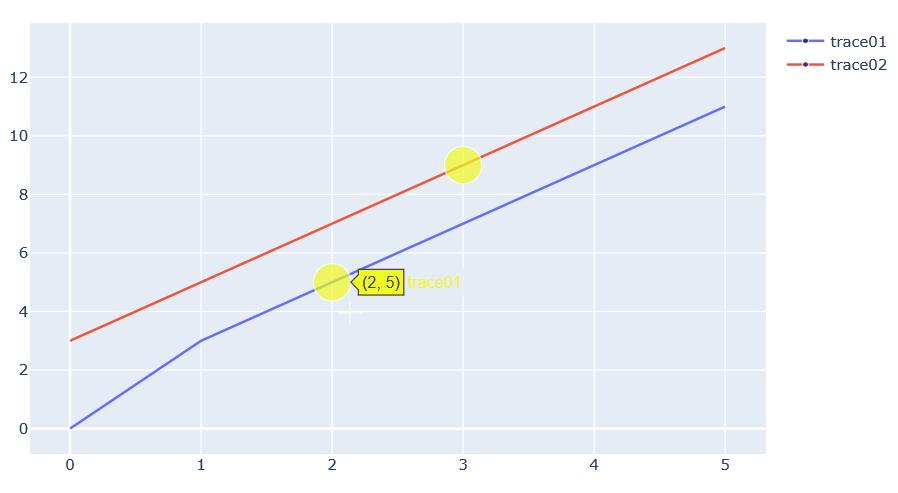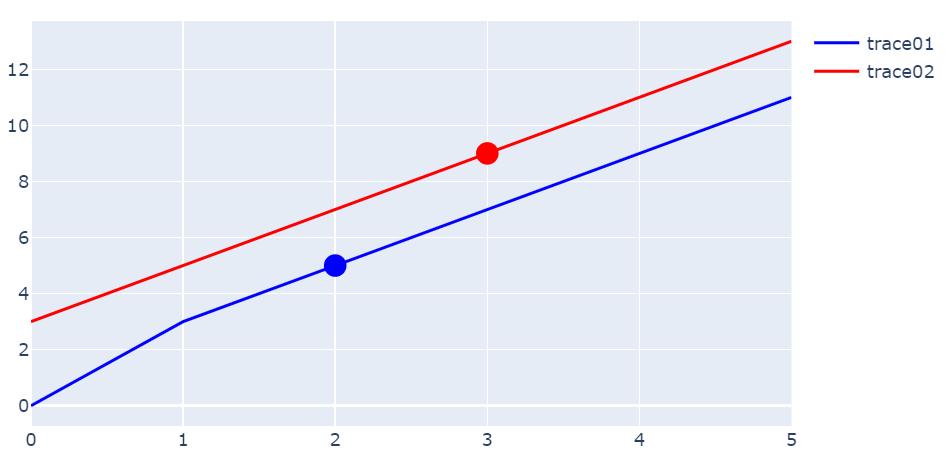I am trying to plot a selected marker for each of my traces in plotly. I would like to assign the same color to marker and line. Is there a way how to get the color attribute of my traces?
fig = go.Figure()
fig.add_trace(go.Scatter(
x=[0, 1, 2, 3, 4, 5],
y=[0, 3, 5, 7, 9, 11],
name='trace01',
mode='lines+markers',
marker=dict(size=[0, 0, 30, 0, 0, 0],
color=[0, 0, 10, 0, 0, 0])
))
fig.add_trace(go.Scatter(
x=[0, 1, 2, 3, 4, 5],
y=[3, 5, 7, 9, 11, 13],
name='trace02',
mode='lines+markers',
marker=dict(size=[0, 0, 0, 30, 0, 0],
color=[0, 0, 0, 10, 0, 0])
))
fig.show()

Updated answer for newer versions of plotly:
For recent plotly versions, a larger number of the attributes of a plotly figure object are readable through fig.data. Now you can retrive the color for a line without defining it or following a color cycle through:
fig.data[0].line.color
To make things a bit more flexible compared to my original answer, I've put together an example where you can have multiple markers on the same line. Markers are organized in a dict like so:
markers = {'trace01':[[2,5], [4,9]],
'trace02':[[3,9]]}
And the essence of my approach to getting the plot below is this snippet:
for d in fig.data:
if d.name in markers.keys():
for m in markers[d.name]:
fig.add_traces(go.Scatter(x=[m[0]], y = [m[1]],
mode='markers',
name=None,
showlegend=False,
marker=dict(color=d.line.color,size=15)
)
)
Here you can see that I'm not actually using fig.data[0].line.color, but rather color=d.line.color since I've matched the markers with the traces by name through :
for d in fig.data:
if d.name in markers.keys():
for m in markers[d.name]:
Plot:

Complete code:
import plotly.graph_objects as go
fig = go.Figure()
fig.add_trace(go.Scatter(
x=[0, 1, 2, 3, 4, 5],
y=[0, 3, 5, 7, 9, 11],
name='trace01',
line=dict(color='blue'),
mode='lines',
))
fig.add_trace(go.Scatter(
x=[0, 1, 2, 3, 4, 5],
y=[3, 5, 7, 9, 11, 13],
name='trace02',
line=dict(color='red'),
mode='lines'
))
markers = {'trace01':[[2,5], [4,9]],
'trace02':[[3,9]]}
for d in fig.data:
if d.name in markers.keys():
for m in markers[d.name]:
fig.add_traces(go.Scatter(x=[m[0]], y = [m[1]],
mode='markers',
name=None,
showlegend=False,
marker=dict(color=d.line.color,size=15)
)
)
fig.show()
Original answer for older versions
You can retrieve the color of a trace using:
fig['data'][0]['line']['color']
But you'll have to specify the color of the trace to be able to do so. Or you can make sure that the color of the markers follow the same sequence as the traces. But we can get to all the details if this is in fact what you're trying to accomplish:

If you study the code snippet below, you'll see that I, unlike you, havent defined the markers in the same go as the lines. Rather, I've added the traces as pure lines with mode='lines' and then added separate traces for the markers with mode='markers'. When doing the latter, I've retrieved the colors of the corresponding lines using color=data['line']['color'] in a loop:
import plotly.graph_objects as go
fig = go.Figure()
fig.add_trace(go.Scatter(
x=[0, 1, 2, 3, 4, 5],
y=[0, 3, 5, 7, 9, 11],
name='trace01',
line=dict(color='blue'),
mode='lines',
))
fig.add_trace(go.Scatter(
x=[0, 1, 2, 3, 4, 5],
y=[3, 5, 7, 9, 11, 13],
name='trace02',
line=dict(color='red'),
mode='lines'
))
markers = [[2,5],
[3,9]]
for i, data in enumerate(fig['data']):
#print(data['line']['color'])
fig.add_trace(go.Scatter(x=[markers[i][0]], y=[markers[i][1]],
mode='markers',
name=None,
showlegend=False,
marker=dict(color=data['line']['color'],
size=15
)))
fig.show()
Edit 1: How to do the same by referencing the default color sequence
By default, plotly follows a color sequence that can be found using px.colors.qualitative.Plotly:
['#636EFA',
'#EF553B',
'#00CC96',
'#AB63FA',
'#FFA15A',
'#19D3F3',
'#FF6692',
'#B6E880',
'#FF97FF',
'#FECB52']
The following snippet will produce the exact same figure as before, but without having to define the colors for the traces.
import plotly.graph_objects as go
import plotly.express as px
fig = go.Figure()
fig.add_trace(go.Scatter(
x=[0, 1, 2, 3, 4, 5],
y=[0, 3, 5, 7, 9, 11],
name='trace01',
mode='lines',
))
fig.add_trace(go.Scatter(
x=[0, 1, 2, 3, 4, 5],
y=[3, 5, 7, 9, 11, 13],
name='trace02',
mode='lines'
))
colors = px.colors.qualitative.Plotly
markers = [[2,5],
[3,9]]
for i, data in enumerate(fig['data']):
#print(data['line']['color'])
fig.add_trace(go.Scatter(x=[markers[i][0]], y=[markers[i][1]],
mode='markers',
name=None,
showlegend=False,
marker=dict(color=colors[i],
size=15
)))
fig.show()









 已为社区贡献126445条内容
已为社区贡献126445条内容

所有评论(0)